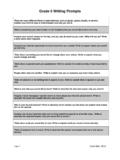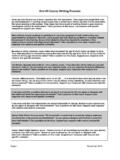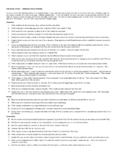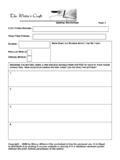Transcription of A Writing Workshop: one teacher’s approach
1 This document found on-line at 1 A Writing workshop : one teacher s approach from Corbett Harrison, NNWP Consultant Structure of my workshop : For many years as a teacher , I successfully implemented a Writing workshop in my classroom. Authentic Writing poured from my students during those semesters. The topics that were written about belonged to my students; the structure of their Writing time was mine. Ideas seemed recklessly up for grabs at times, yet learning always occurred. It was an exciting time to teach, and it was my Writing workshop that made it happen inside my classroom. I based my classroom workshop on a presentation I d seen by fellow NNWP-consultant Candy Carter up at McQueen High School. I had only been a Writing Project consultant for less than a year then, and I was still looking for better ways to structure the Writing classroom I was attempting to build.
2 When students came back to me the following fall, I introduced them to a new structure that would dominate my classroom. Candy had generously shared her workshop format, which ended up being subtly different structurally from my own. When it comes to a Writing workshop , I think it s good when teachers don t take exact structures from fellow teachers; workshops need to be 50 percent borrowed, 50 percent self-created. Take what you want from these following pages, but don t integrate yours exactly like mine. Add those pieces that make the workshop unique to your style of teaching. My Writing workshop schedule: My Writing workshop s overarching goal & schedule: In eighteen weeks, students will take 5 papers completely through the Writing process. Ideas for Writing topics will be explored through the students daily use of journals in response to class curriculum. Ideas are then drafted into papers and worked through the entire process on the one day a week committed to Writing workshop .
3 Final drafts are reflected upon, and they end up in the students portfolios. The first assignment for their portfolios will be a highly-structured, all-class assignment that should take 3 to 4 weeks to finish. The entire class walks step-by-step through the Writing process (drafting, responding, revising, editing, and publishing) with this first paper, so they can independently repeat the process four more times. All topics after the first assignment are to be chosen by the students. Three different genres will be represented in each student s portfolio at the end of this process, and the portfolio papers will be scored using a 6-traits rubric. Mini-lessons on the different genres and the 6 traits will occur throughout the semester. Monday Tuesday Wednesday Thursday Friday Daily journal write (5-10 minutes) Students use journals to explore topics that might become larger papers on Fridays.
4 Optional journal prompts asked them to explore themes from my classroom s literature. Daily journal write (5-10 minutes) Students use journals to explore topics that might become larger papers on Fridays. Optional journal prompts asked them to explore themes from my classroom s literature. Daily journal write (5-10 minutes) Students use journals to explore topics that might become larger papers on Fridays. Optional journal prompts asked them to explore themes from my classroom s literature. Daily journal write (5-10 minutes) Students use journals to explore topics that might become larger papers on Fridays. Optional journal prompts asked them to explore themes from my classroom s literature. Writing workshop (Full period) Students spend the entire period drafting, responding, revising, editing, or publishing a piece of Writing that will end up in their portfolios. My workshop worked this way: Monday through Thursday, we wrote in our journals.
5 Our journals were places to begin interesting idea development through Writing . I challenged students with daily journal Writing time to either a) write what was on their minds or b) write their ideas on a topic of This document found on-line at 2 relevance to what was going on in class itself or in the class s literature. I warned them that they were required to write to the assigned topic several times a week to make sure some of their Writing linked back to my curriculum. I needed student journals to be seen as places to not only write freely but also to write about the big picture ideas from my daily lessons on literature and language. My big picture for them was a five-paper portfolio; I had my students for 18 weeks, and I thought they could achieve that if they were given one day out of the week (Friday) to take an idea from their journals and attempt to turn it into a bigger statement through Writing and the Writing process.
6 Had I done this with a year-long class, I probably would have only increased the number of portfolio papers to eight, but I would add harder assignment elements to one or two of the required portfolio assignments. The first paper was a well-explained, step-by-step walk through the Writing process. For three weeks, we shaped an idea based on a mutual class assignment. We talked about the shape of our ideas with each other. We learned how to take and make suggestions based on 6-trait mini-lessons throughout those three weeks. Even the reluctant revised. As a class, we edited, and we created a final draft of the idea that had begun as a simple Writing prompt on the first or second day of class. A week after the first paper was completed, I told them it was time to begin the same journey again. I told them they d be taking this journey four more times as the semester progressed, and the product at the end of their explorations would determine the majority of their grades for the class.
7 They were to go back into their journals and find some smaller idea they d written about and attempt to turn it into a more profound piece of deeper thought. All this would be done through Writing , of course. We created portfolio folders to hold their first papers, which were graded using the traits as criteria, and prepared space for the next four papers to come. On Fridays, they learned the routine: a) check-in with Mr. Harrison by telling him where you are in the Writing process with your current portfolio assignment and b) be able to show that you ve made it to the next step in the process by the end of workshop . Thoughts moved in and out of my classroom as the students took their portfolio responsibilities to task. Ideas to write about were discovered both independently and from classroom discussions. My students approached journaling in a different way those years.
8 They began to understand that the five to ten minutes I gave them daily to write their ideas had an important purpose. They liked their journals. They saw them more authentically. Some struggled to fill their portfolios with five papers. Many had the time to write more six or sometimes seven papers; I told those students that six papers would earn them a place on the Hall of Fame Poster I d created, which believe it or not was actually a good enough incentive. I d also told these students that seven carefully crafted papers was the only guaranteed way to get an A in my class these days, and that information kept them focused on their portfolios for all eighteen Fridays we wrote together. I always passed the students who made it through three or four of the paper assignments, as long as they never got caught goofing off during Friday Writing time. Both my special education and English language learning students succeeded within this structure.
9 The first year I tried it, I had much success but equal amounts of struggle. I modified for year two, but it wasn t until year three that I felt I had it to where I wanted it. I used it in all my classes (I had poetry, mythology, and sophomore composition back then) because it worked so well with any type of curriculum. My students got it! They realized how they were required to think while in my classroom, and that the majority of their grade was earned while taking five of their independent thoughts through the Writing process. I loved my classroom those years. I remember my students by their papers, by their independent explorations through Writing . There was excitement in my classroom back then, and our daily lessons, when we weren t doing the Friday workshop thing, often ended with questions like, Can write about this [what we had learned that day] and put it in our portfolio?
10 Writing workshop built a great community for my classroom. My Writing workshop resources are found on the next 16 pages. This document found on-line at 3 A Writing workshop Introductory Handout for Students Keep this page with your Writing folder. During the course of the semester, you will be required to turn in five separate, polished pieces that show your developing skills as a writer. Each piece must be thorough and complete. Not having five polished and revised pieces in your portfolio at the end of the semester might cost you your English credit. The topics for your pieces are to be your own choice, but you may use any ideas, literature, or journal pieces from class to help you choose a topic for your paper. At the end of the semester, your portfolio must contain the following: 1 creative : to entertain the reader 1 informative : to present factual information 1 persuasive : to examine a controversy 2 "own choice" : any purpose See the attached page for explanations of these types of Writing .








